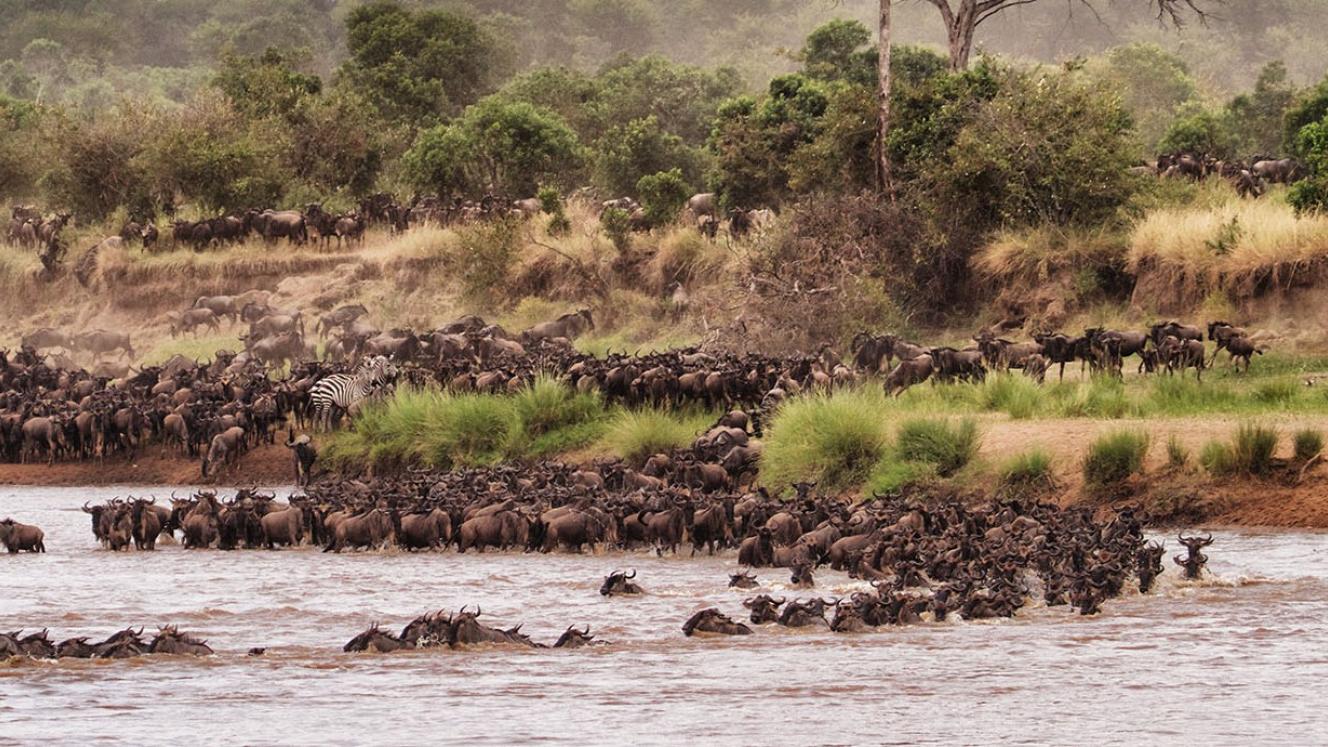Disruption of wildlife movements by tourists during East Africa’s peak migration season has again been thrust into the spotlight – this time in Kenya’s Maasai Mara National Reserve.
New video footage emerged on social media on August 19, showing a crowd of tourists standing in the path of wildebeest attempting to exit the Mara River near the reserve’s Purungat Gate. This follows similar imagery posted from Tanzania’s Serengeti National Park in July.
Kenya’s Ministry of Tourism and Wildlife, along with several other stakeholders, claim the Maasai Mara incident occurred away from a wildebeest crossing and in an area where tourists were permitted to alight from vehicles.
“The area has a well-known nature walk where tourists can exit their vehicles and view hippos. Flooding in the river meant that migrating wildebeest at a crossing point further upstream were swept downriver. The exiting wildebeest were trying to escape the flood waters, unfortunately, at the spot where the tourists were gathered,” explained tour operator and guide Gaurav Bhandari.
Bhandari said the rangers on site were quick to react.
“The authorities acted very quickly under the circumstances to ensure no tourists were injured and to minimise disruption to the wildlife. They also closed the section immediately after the incident.”
The Ministry of Tourism and Wildlife said, while background context is important, it remains deeply concerned about the images, given growing concerns about overcrowding at tourist hotspots in the reserve.
“It is imperative that all stakeholders – government, tour operators and visitors – uphold the highest standards of conduct to protect wildlife and visitor safety,” said the Ministry’s Cabinet Secretary Rebecca Miano.
Breach of regulations?
Tour Operators Society of Kenya Chairperson Daniel Mbugua described the incident as “unacceptable and contrary to park regulations”.
He said: “The chaos witnessed undermines visitor safety, disrupts wildlife and tarnishes Kenya’s global reputation as a premier tourism destination. A thorough investigation should be undertaken and appropriate measures enforced against any parties found negligent.”
Mbugua called on tour operators and tourism establishments to ensure clients are serviced exclusively by registered and licensed tour operators and professional tour guides.
A Gold Level guide registered with the Kenya Professional Safari Guides Association, who spoke to Tourism Update on condition of anonymity, said swifter action should have been taken to prevent the latest incident.
“It’s clear to see that the tourists were lined up ready with their cameras and that those on site were well aware that wildebeest were about to exit the river. Once this was noticed, all the tourists should have been directed to get away from the site and back into their vehicles,” the guide said.
The incident is a small reflection of the broader overcrowding problems that continue to occur on a “daily basis” during the Maasai Mara’s peak season, he added.
“Away from the viral clips, we experience these issues every day and it doesn’t only include wildebeest crossings. This week, we had a sighting of a leopard with a kill in a tree and two cubs watching from a distance. The cubs wanted to approach their mother but, once the sighting was called in on the radio, dozens of vehicles pitched up and totally disrupted the interaction,” the guide said.
Regulatory authority reacts
Kenya’s Tourism Regulatory Authority (TRA) has launched a nationwide crackdown, starting in the Maasai Mara, on unlicensed and non-compliant operators in response to an increase in reports of rogue drivers and vehicle harassment.
The TRA said those found breaking the law will face fines and possible legal action, stressing that regular updates of licensed operators will be published online for transparency and easy verification.
The guide who spoke to Tourism Update said the move is “far too reactive”.
“Why have the TRA, the Ministry of Tourism and Wildlife and the Kenya Wildlife Service not implemented these efforts sooner, considering that the same incidents are repeated year after year?”
Miano reiterated the importance of the Narok County government strictly enforcing park rules and bolstering its ranger complements.
“Visitor safety and wildlife protection are paramount. Preventing dangerous interactions safeguards lives and conservation integrity.”
She said clearer signage and visitor education information will be introduced at key gates and migration viewing points to prevent future incidents.













